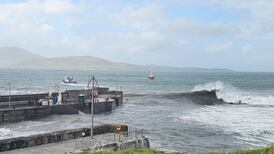Our cargo ship, the Polamhall, was being pushed and pulled into the berth in Manhattan in New York by two powerful tugboats that had a big white letter M on their stubby black funnels.
I asked the gaunt-faced harbour pilot what the letter stood for. He said: “M for Moran” using the US pronunciation of the Irish name. He said:“The Morans and the McAllisters are two big names in the tug business here. Irish guys. They’ve been around for years.”
I found out later that indeed these two tugboat operators were dominant in one of the biggest natural harbour areas of the world where the East river and the Hudson river meet the Atlantic.
It’s called New York harbour but in fact there are 11 ports, with docks along the waterfronts in Manhattan, Brooklyn. Queens, the Bronx as well as the New Jersey shoreline with wharves in places like Newark, Jersey City and Hoboken.
The completion of the impressive Erie canal in 1825 to link the Great Lakes to the Hudson river ensured that New York would be the centre of trade for the eastern seaboard of a country that was expanding with extraordinary energy and enterprise.
Passenger ships from Europe, crowded with emigrants and visitors, steamed in weekly.
After the civil war, several major railroads set up bustling freight depots along the waterfronts.
Ships and barges moved in and out, to and fro across the wide harbour area, pushed and shepherded by very accomplished tugboat skippers. By 1929, over 700 tugs, many still steam-driven, were ploughing across the busy waters, their high funnels sending up clouds of smoke.
Moran Towing Corporation began in 1855 when Michael Moran, a 22-year-old Irish immigrant, saved the money earned as a mule-driver on the Erie canal to buy a barge.
In a region where bulk goods were most easily carried along waterways, he began to build up the barge business.
Then, in 1863, he set up his tugboat operation in New York harbour and gradually expanded it, vessel by vessel.
Morans achieved fame in 1904 when it set a record for long-distance hauls, towing a barge from New York to San Francisco, a 13,000-mile voyage.
This was before the opening of the Panama Canal in 1914 when the only route for shipping from the east to the west coasts of the US was round the hazardous Cape Horn on the tip of South America.
The thriving enterprise was managed by family members down the years as their tugs increased in power and number. The familiar M on the smokestacks became an established part of the New York harbour scene.
In the second World War, one of the Morans was put in charge of the vast armada of barges that were towed across the English Channel carrying concrete caissons and steel piers to build man-made harbours during and after the invasion of Normandy in 1944.
Incidentally, in later years the family tried but failed to identify the place where their founding father came from in Ireland.
The equally dominant tugboat company of Irish origin is McAllisters. It began with the arrival in New York in 1864 of James McAllister, who came from Cushendall, in Co Antrim. Soon he was joined by his brothers.
They saw the potential in the busy water traffic in the harbour area. McAllister began with a lighter, a shallow draft boat, transferring cargo from ships at anchorages to nearby piers. This work needed a lot of skilful handling, later put to use when a lighter was converted into a bulk oil carrier to transport oil around the harbour. The company then moved into the towing business.
The first tugboat began working in 1876 when the Brooklyn Bridge was being built. Some years later the company expanded into providing excursion steamboats to view the great maritime scene.
By 1918 McAllisters were towing ocean cargo. One of the company’s notable achievements was working a tugboat-barge combination that carried a large cargo of molasses from Cuba across the Gulf of Mexico and up the Mississippi to New Orleans. In 1927, the company launched the first diesel-powered tug in New York harbour and it gradually moved from steam to oil power.
Between the two World Wars, the US government employed McAallister to operate a fleet of tankers to supply its army bases at home and overseas.
Along with Morans they became a very visible presence in New York harbour, where liners, bulk carriers, oil tankers, cargo ships of all kinds need to be carefully nudged and hauled in and out of dock.
These tugs became famous for their mastery and timing in manoeuvring ships into narrow spaces or guiding them along crowded channels.
The pilot that took our ship into port said: “The joke was that the tugboats in New York harbour were the Irish navy.”









